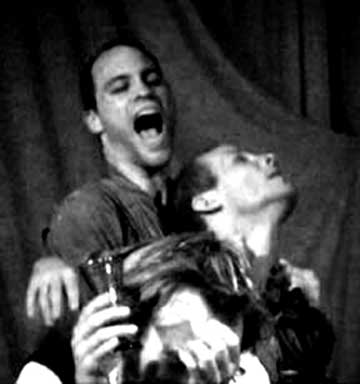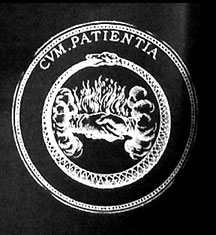GREY LODGE OCCULT REVIEW
John Wisniewski Interviews Antero Alli
Wednesday March 25, 2009
John Wisniewski: Can we start with cinema. Is your film “Drivetime” about unleashing powers of chaos by using chaos magic? I do not know if I have this right?
ANTERO ALLI: Intriguing interpretation. Though I did not intend make “The Drivetime” as a vehicle for chaos magick, I can see how it could be experienced like that. I wrote “The Drivetime” on the heels of kicking an opium addiction while living in the seaside village of Port Townsend Washington back in 1995. Papaver somniferum blooms wild all over the streets about three months each year and I learned everything you need to know about chasing the dragon from Jim Hogshire’s book, “Opium for the Masses” (Loompanics, Ltd). I was desperate to trade up my opium addiction for an endorphin trigger that wouldn’t vanquish my libido. Inspiration hit when my friend Rob Brezsny, the astrology columnist, introduced me to his spin on the term “drivetime” which refers to the psychic overlays linking daytime and dreamtime realities. This drivetime meme exploded in my imagination and got me thinking about the interface between the aboriginal dreamtime and modern-day cyberspace.
I’m at a loss for words as to just how I upgraded my opium addiction to getting hooked on the poetic imagination but that’s what happened. The drivetime was no longer an idea in my head but an all-encompassing reality that needed an outlet besides my body and so, the momentum was on to channel these visions through the multi-tiered outlet of a cyber-fi feature film. My aim in making the film was to proffer for the viewer an experience of the drivetime as I knew it. And so, I suppose maybe I did unleash the powers of chaos using chaos magic afterall.
JW: Who are some filmmakers who have inspired you?
AA: Andrei Tarkovsky is my favorite filmmaker. I don’t watch his work often because it simply crushes my filmmaking ambitions to see such power onscreen. “The Mirror”, “Stalker”, “The Sacrifice” and “Nostalgia” are all cinematic masterpieces. I am also floored by the originality and sheer guts of Werner Herzog’s documentaries and his early features, “Kaspar Hauser” and “Aguirre, Wrath of God”. Lars von Trier’s films have inspired my camerawork with a spirit of adventure, especially “The Element of Crime” and “Breaking the Waves”.
I love the economical, no-bullshit styile of acting, directing and writing of David Mamet and Robert Bresson, though for different reasons with both. The highly imaginative Canadian filmmaker Guy Maddin’s films seduced me into using treated Super-8 film stock in three of my features. Though I often disagree with his metaphysics, I deeply adore the theatrical genius called Alexandro Jodorowsky. The thread that runs through them all is the visionary factor; they are all creating visionary cinema, a conceit I aspire towards in my own work. Other filmmakers that I deeply respect include Ingmar Bergman , Lech Majewski, Jim Jarmusch, David Lynch, Jean Cocteau, John Cassavetes, Harmony Korine , Terrence Malick, Terry Gilliam and Wim Wenders.

Antero Alli in "The Invisible Forest" (2008)
JW: What were your first artistic works ? Were they films or dance choreography?
AA: My so-called artistic work began with reams of warped cartoon panels inspired by Robert Crumb that kept me sane throughout my high school pharmaceutical experimentation. This was in Los Angeles, the late sixties. After high school, my earliest artistic training was in Mime Theatre; not the cutesy Marcel Marceau schtick but my own spin on the darker, dramatic silent art form born at the American Mime Theatre in NYC. My first public production was a full-length Mime Play, “CIRCLES”, which premiered in Berkeley California in 1975. For the next ten years, I made an art out of poverty so I could focus entirely on creating experimental theatre. During this time, I wrote and directed seven stage plays exploring the internal landscapes of dreams and what I call the metaphysics of social collapse, themes that continued into my cinematic work starting around 1990. Keep in mind that since 1977, I was working clandestinely in predominantly private paratheatre experiments with groups of performers and non-performers alike. I don’t count paratheatre as artistic work as much as an infrastructure for what keeps me linked with the underlying sources fueling my art. It would not be inaccurate to define this paratheatre process as a ritual technology for Self-initiation.

from "Orphans of Delirium" (2004)
JW: Your work with paratheatre seeks to delve into the subconscious through physical action? Could you tell us how this is accomplished? How do you direct your performers to use their body to create?
AA: I direct each and every performer differently due to their unique limitations, talents, strengths, history and dispositions. Some performers work best by being told what to do and/or by holding their hand through the process, which I don’t mind doing if they have talent. The most talented and hardest working performers don’t seem to need much or any direction at all beyond me giving them an objective based on what needs to be done. My directing style is highly collaborative yet within the framework of benevolent tyranny.
Though I have final cut and final say, I always listen to the ideas of others and follow the axiom “the best idea wins”, no matter where it comes from. I also only work with those I share good communication and rapport with. No matter how monstrous their talent or genius if we do not get along, I see no point in working together. I mean, a certain amount of creative conflict is necessary to produce vital work but without a basic underlying affinity and rapport, things can rapidly degenerate into a cacophony of barnyard soap opera antics. As for using their bodies to create, this depends on the specific demands of the given project, the scene at hand or the moment we are in.
Since each performer has their own somatic signature — how they relate with their bodies — their unique kinetic processes need to be recognized, encouraged but also challenged. Typically, I find that saying less works best when Im dealing with directing performers in physical actions. I talk to the body, not the mind. I dont spell things out. Maybe I will talk in incompletes, leave blank spaces. Give them an image instead of a word. Bodies don’t need to make sense of things; they just want to move and be moved. Bodies tend to also resist directions that are too well defined or too mentally convoluted. If you have to think too much about an action it's probably not worth doing.
JW: How do you apply Timothy Leary’s "8 points of consciousness” to your work?
AA: In general, I prefer to keep my mind relatively system-free for these very reasons. I don’t really like to use any system unless it’s necessary to do so. Systems are tools at best. And when you’re done using one, hopefully you can put it back in the toolbox. Otherwise, these symbol systems — whether it be the 8-circuit model, kabbalah, astrology, the enneagram, or quantum physics — well, they can spread like a hungry ghost virus and own you. At least that’s the way I’ve seen it so far.
With that said, I applaud Dr. Leary for his brilliant contribution to the field of Intelligence Increase that blew open the doors for Robert Anton Wilson’s imaginative and well-researched spin on this system in his 1985 book, “Prometheus Rising”, which also inspired the writing of “Angel Tech”. Contrary to popular belief, Leary did not originate what he coined as the 8-Circuit Brain. Back in the early sixties at Millbrook, a scholar from Rutger’s named Dr. Adams introduced Leary to an ancient esoteric and tantric study of the Hindu Chakra system that Leary fully absorbed and proceeded to re-interpret through his own background and bias as a social scientist and psychologist; hence, the term “circuit” to reflect the upcoming computer age. I could discuss this system more at length but Im afraid to derail this interview unless there is something specific you wish to discuss about the 8-Circuit Brain model.


